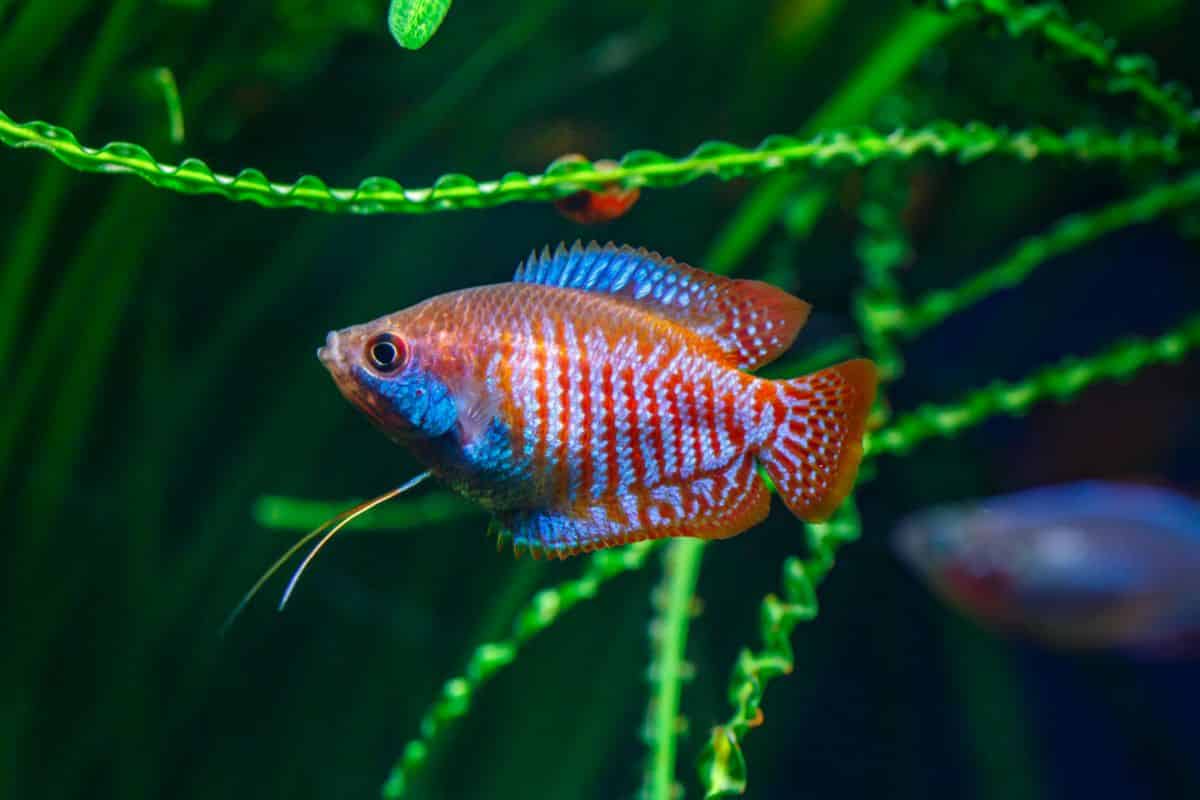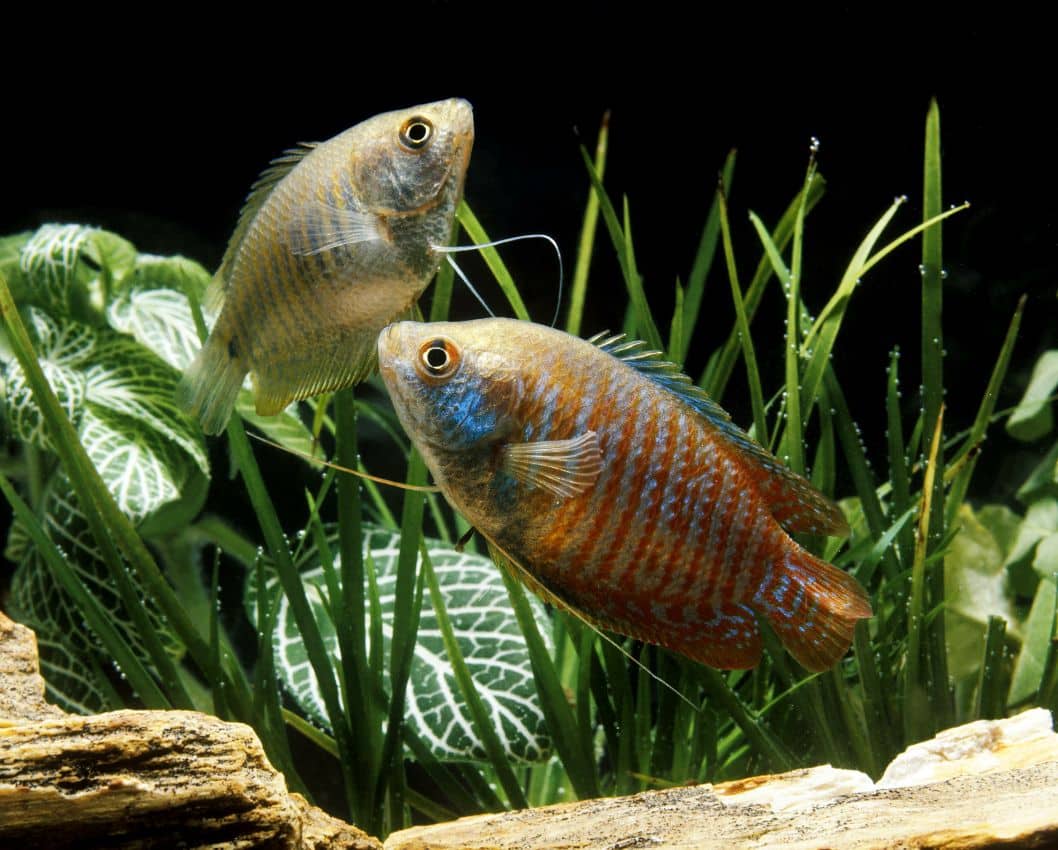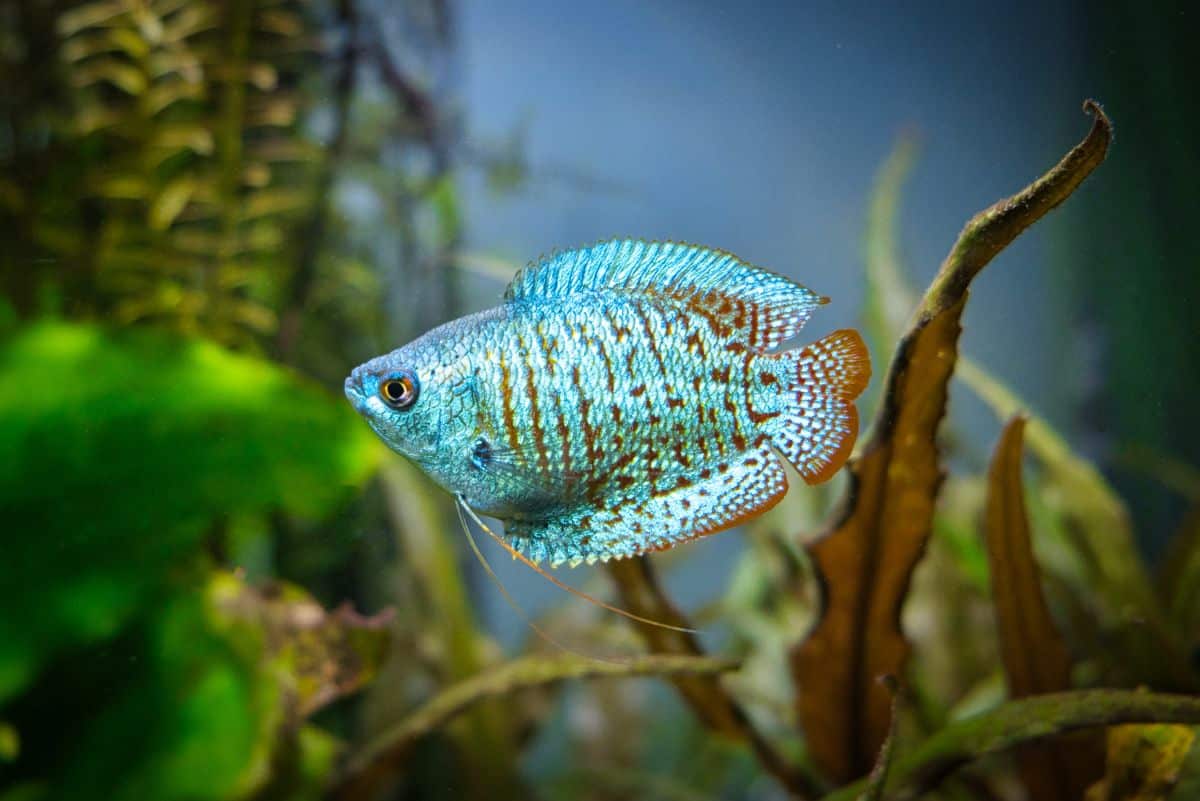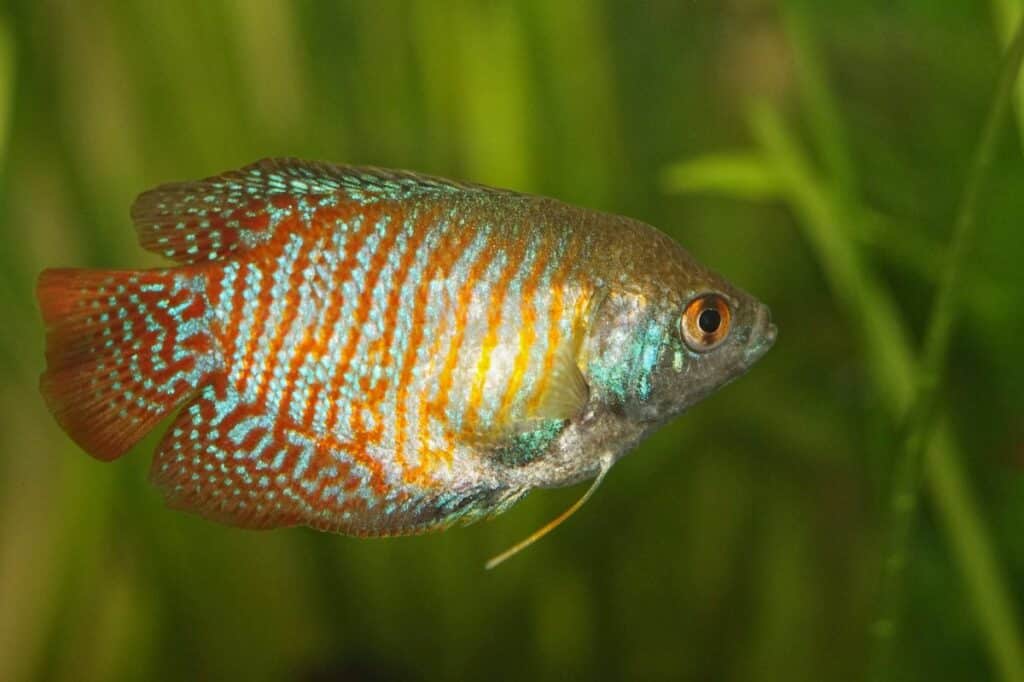the essentials in brief
It is recommended to keep dwarf gourami in a group of at least five specimens. You can find out more about posture here...
Dwarf gouramis can be kept well together with other peaceful fish species such as shrimp, Corydoras catfish or peaceful dwarf cichlids. To the essence...
The average life expectancy of dwarf gourami is about two to four years.
The dwarf gourami is a fascinating and attractive fish, which is a popular resident of the aquarium due to its appearance and interesting behavior. Keeping this small species of fish requires certain conditions for the animals to feel comfortable and healthy. In order to create an optimal home for the dwarf gouramis, there are a number of important aspects to consider, from the aquarium size to the water parameters and feeding.
In this article you will get information about the appearance, the character and the attitude of these fish.
Appearance

Dwarf Gourami, Scientific Trichogaster lalius are fascinating and attractive species of fish that are kept in many aquariums for their beautiful appearance and interesting behavior. These little fish are originally from South Asia and belong to the gourami family (Osphronemidae).
The males of the dwarf gouramis are very conspicuous. you have one elongated body shape and become about five to six centimeters long. Their body is flattened laterally and the dorsal fin is rounded.
The basic coloring of the males varies depending on the subspecies and breeding form. Typically they have one light blue to turquoise basic coloration, with dark vertical stripes along the body is decorated. These stripes can be blackish to dark blue. Additionally, the males can have red, blue, or black accents on their fins, giving them a particularly attractive look. A striking feature of the males are the elongated fin rays in the dorsal and anal fins. During courtship or when aroused, they can spread these fins and display magnificent patterns. The eyes are striking and bright red.
The females of the dwarf gouramis are slightly smaller than the males and have one rounder body shape. They usually reach a maximum length of about four to five centimeters. The basic coloring of the females is usually paler than that of males and varies from yellowish to light brown to gray. Like the males, the females also have vertical stripes on the sides of their bodies, but these are less pronounced. The fins of the females are Kurzer than those of the males, and their dorsal and anal fins are less prominent.
Additional information: Another striking feature of both sexes of dwarf gouramis is their labyrinthine organ, with which they can absorb oxygen from the air. This allows them to survive in oxygen-poor waters due to their ability to swim to the surface and breathe air.
beings
The dwarf gourami is not only known for its attractive appearance, but also for its interesting nature. This shows some behavioral characteristics that make them fascinating aquarium inhabitants.
Dwarf gourami are generally peaceful and quiet Fish. They are sociable animals and are most comfortable when kept in a group. In a harmonious community, they can keep each other company and feel safer. It is recommended to keep them in groups of at least five animals, with a balanced ratio between males and females.
This style is for her interesting courtship behavior known. During the mating season, the males put on an impressive display, displaying their rich colors and elongated fin rays. They swim around, spread their fins and present themselves to the females. This behavior serves to attract the attention of the females and to signal their readiness to mate. The females can react to courtship with more intense coloring or increased activity.
are dwarf gourami labyrinth fish, ie they have a special breathing organ, the labyrinth organ. They use this organ to absorb oxygen from the air by swimming to the surface of the water and breathing in air. This allows them to survive in oxygen-poor waters. It is fascinating to watch as they swim to the surface and expel small air bubbles to oxygenate their labyrinthine organs.
Note: Although dwarf gouramis are generally peaceful, territorial wars can occur when socialized with other fish species, particularly during the breeding season. Male dwarf gouramis can defend their territory and behave aggressively towards other males. It is therefore important to offer them enough space and hiding places in the aquarium to minimize conflicts.

posture, attitude
The keeping of dwarf gouramis, scientifically called Trichogaster lalius, requires some special conditions so that the animals feel comfortable and healthy. Here are some important aspects to consider when keeping this fascinating species of fish:
- Aquarium size: Dwarf gourami are relatively small fish, but should still be kept in a sufficiently large aquarium. An aquarium size of at least 60 liters is recommended to give the fish enough swimming space and hiding places.
- water values: Dwarf gouramis prefer soft and slightly acidic water. The pH value should ideally be between 6,0 and 7,5, the water hardness between 5 and 12 dH (German hardness). The water temperature should be constant at around 24-28 °C.
- Aquarium equipment: It is important to set up the aquarium according to the natural habitat of the dwarf gouramis. Use fine gravel or sand as substrate and add various hiding places such as plants, roots, caves or snail shells. These offer the fish protection and retreat options. Plants such as java fern, types of moss or floating plants are particularly popular and create a natural atmosphere in the aquarium.
- Lighting: Subdued lighting is recommended to provide a comfortable environment for the dwarf gouramis. A combination of natural and artificial lighting can be used to simulate a day-night cycle.
- social behavior: Gourami are social fish and should be kept in groups of at least five individuals. A balanced relationship between males and females is important to minimize potential conflicts. Generally, dwarf gouramis are peaceful, but males can be territorial, especially during the mating season. Provide enough space and hiding places to avoid conflicts.
- Feeding: Gourami are omnivores and will eat both live and dry food. A varied feeding with high-quality flake food, granules, frozen food or live food such as artemia, daphnia or mosquito larvae is recommended to ensure optimal nutrition.
- Water quality and care: Regular water changes and good filtration are crucial for good water quality. Regularly check the water parameters and remove excess food and waste to maintain the water quality.
Dwarf gourami are relatively easy to care for and are suitable for both beginners and experienced aquarists. With the right attitude and care, they can become active, colorful and fascinating aquarium inhabitants.
Additional information: The life expectancy of the fish is two to four years.

A great species of fish
Because of their attractive appearance, interesting behavior, and relatively easy maintenance, dwarf gouramis are fascinating and popular fish. Given the right conditions, including the right aquarium size, water parameters, setup and feeding, dwarf gouramis can be colorful and fascinating residents of a community aquarium.
It is important to look after their welfare, regularly check the water quality and provide them with an appropriate group size and environment. With the right care, dwarf gouramis can become an enriching addition worth watching for every aquarist.


